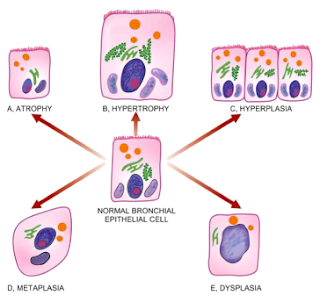Understand some terms:
Atrophy
Hypertrophy
Hyperplasia
Causes:
Metaplasia
Two type of
metaplasia: Epithelial and Mesenchymal
1. Epithelial Metaplasia
It is a common one. It is further divided into squamous metaplasia and columnar metaplasia
2. Mesenchymal Metaplasia
It occurs less often. Two types of mesenchymal
metaplasia, they are
Osseous metaplasia is formation of bone in fibrous
tissue, cartilage and myxoid tissue. E.g. In arterial wall in old age, In
cartilage of larynx and bronchi in elderly people.
Cartilaginous
metaplasia – In healing of fractures, cartilaginous metaplasis may occur where
there is undue mobility.
Dysplasia
- Increased number
of layers of epithelial cells
- Cellular
and nuclear pleomorphism
- Disorderly
arrangement of cells from basal layer to surface layer
- Increased
mitotic activity



